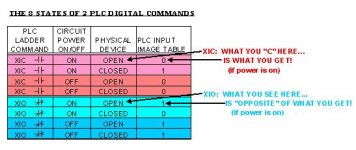That question cannot be answered until you know WHAT the PLC intruction for that address should DO. If your physical device is a START pushbutton, then you would want your PLC instruction to produce a TRUE or "1" when the pushbutton closes or goes TRUE. So then you would use a Examine if Closed (XIC), because it always returns the SAME as the physical device (which is TRUE when closed).
So when the input fied device (not the PLC instruction) goes from normally open to closed (button is pressed), then we want the solenoid to go TRUE or ON. What instruction produces the SAME TRUE output as the field device does in this case? What you C is what you get with the XIC. When the XIC sees the TRUE at the input terminal, then it produces a TRUE output which then turns on the solenoid.
Yes, and No. Within the same Allen Bradley PLC brand, for digital ON/OFF inputs you would always use the same XIC or XIO instructions. (For analog inputs in any brand of PLC, that is a different ballgame). But for other brand and models of PLCs, the digital input mnemonics are completely different (but mostly the same symbols | | and |/| are used).




